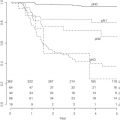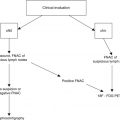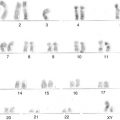Fig. 11.1
Imaging studies including (a, b) PET/CT scan, (c) diagnostic CT scan, and (d) sagittal MRI scan of a patient with a suspected T3N3M0 penile cancer extending into the urethra and suspicious inguinal and iliac lymph nodes. PET/CT imaging (a, b) demonstrates increased FDG update in the region of the penis, as well as the bilateral inguinal and the left iliac region. Diagnostic CT scan (c) demonstrates inguinal lymphadenopathy. (d) MRI of the penis demonstrates a large mass extending into the urethra (arrows)
Staging
The two most common staging systems for penile cancer include the Jackson staging system [40] and the AJCC/UICC TNM staging system [20]. Both are shown in Table 11.1.
Table 11.1
Summary of the Jackson and the AJCC/UICC staging systems for penile cancer
Jackson staging system [40] | |||
Stage I | Cancer confined to glans or prepuce | ||
Stage II | Cancer invades into shaft or corpora | ||
Stage III | Operable inguinal lymph node metastasis | ||
Stage IV | Tumor invades adjacent structures or there are inoperable inguinal lymph nodes | ||
AJCC/UICC staging system, 7th edition [20] | |||
T0 | No evidence of primary tumor | ||
Tis | Carcinoma in situ | ||
Ta | Noninvasive verrucous carcinoma | ||
T1a | Tumor invades subepithelial connective tissue without lymphovascular invasion and is not poorly differentiated | ||
T1b | Tumor invades subepithelial connective tissue with lymphovascular invasion or is poorly differentiated | ||
T2 | Tumor invades corpus spongiosum or cavernosum | ||
T3 | Tumor invades urethra | ||
T4 | Tumor invades other adjacent structures | ||
N0 | No palpable or visible enlarged inguinal lymph nodes | ||
N1 | Palpable, mobile, single unilateral inguinal lymph nodes | ||
N2 | Palpable, mobile, multiple or bilateral inguinal lymph nodes | ||
N3 | Palpable, fixed, inguinal nodal mass or pelvic lymphadenopathy (unilateral or bilateral) | ||
M0 | No distant metastases | ||
M1 | Distant metastases | ||
Stage groupings | |||
Stage 0 | Tis, Ta | N0 | M0 |
Stage I | T1a | N0 | M0 |
Stage II | T1b-T3 | N0 | M0 |
Stage IIIA | T1-3 | N1 | M0 |
Stage IIIB | T1-3 | N2 | M0 |
Stage IV | T4 | Any N | M0 |
Any T | N3 | M0 | |
Any T | Any N | M1 | |
Since much of the literature for radiation therapy spans several decades, it is important to be aware of the differences in the older staging systems. The UICC TNM 3rd edition was published in 1978 and used tumor size and, to a lesser degree, depth of invasion as the main determinants of T-stage (T1, ≤2 cm and superficial; T2, >2 cm and ≤5 cm; T3, >5 cm or with deep invasion including urethra; and T4, invasion of adjacent structures) [39]. The main difference between the 3rd and 4th editions has been the change from size-based tumor staging to one based on the depth of invasion [30]. Since the 4th edition, there have not been any significant changes in the staging for penile cancer in the AJCC/UICC staging systems.
Prognostic Factors
The most important prognostic factors include the size and extent of the primary lesion, tumor grade, and the presence of inguinal and pelvic lymphadenopathy. The risk of nodal involvement increases with tumor size and depth of invasion [59]. Several studies have also demonstrated that tumor grade impacts the risk of local relapse and lymph node metastases as well as survival [11, 15, 61, 69, 77]. The most important factor predicting survival is the presence and extent of lymph node metastases. Because lymph node metastases tend to occur in a stepwise fashion, and skip metastases to the pelvis are uncommon, patients with early superficial inguinal metastases may not have significantly diminished outcome. However, as the inguinal lymphatic tumor burden increases or with the presence of pelvic node metastases, outcomes worsen significantly [45, 47, 48, 61, 70, 81, 86]. Other risk factors include the presence of vascular invasion and histologic subtype [22, 79].
Based on these risk factors, patients can be classified into risk groups. Various classification systems have been developed [10, 37, 38, 55, 70]. From a treatment outcome perspective, low risk would include patients with T1 tumors, low-grade histology, and negative inguinal lymph nodes. Locally advanced disease would include T3–T4 tumors; multiple, large, or matted inguinal lymph nodes; extracapsular extension; or extension to pelvic LNs. Various risk stratification systems have been developed to estimate the risk of pathologic inguinal node involvement in the setting of clinically negative nodes [38, 55, 70]. In general, patients with Tis, Ta, or T1G1 tumors are considered low risk and surveillance is recommended. Patients with T1G2 tumors are considered intermediate risk, and evaluation of additional risk factors such as the presence of perineural and lymphovascular invasion, tumor size, and depth of invasion is recommended to better estimate the risk of inguinal lymph node involvement. Any tumor greater than T1 or grade 2 is considered high risk and lymph node evaluation with either dynamic sentinel node biopsy or lymphadenectomy is recommended.
Treatment of Penile Cancer with Radiation Therapy
Radiotherapy allows the potential for organ-sparing in the management of early stage and locally advanced penile cancer. Although penectomy, either partial or complete, provides excellent local control, it is associated with considerable psychological and sexual morbidity [57, 60]. Because of this, there is a growing trend towards organ-sparing treatment as reflected in the updated European Association of Urology guidelines [80]. The purpose of using radiation therapy for organ sparing is to achieve similar treatment outcomes to penectomy while maintaining organ function and reducing morbidity [58].
For most early stage penile cancers, radiation treatment is performed with either brachytherapy or megavoltage treatment machines. The only exception to this may be a small superficial noninvasive tumor, which could potentially be treated with more superficial radiation therapy utilizing a hypofractionated regimen [12, 53]. This type of treatment should be reserved for carefully selected patients with early stage tumors, the majority of whom can be treated with organ-sparing surgical techniques or laser therapy. The choice between external beam radiation and brachytherapy depends on the location and size of the tumor as well as availability of equipment and expertise [12]. External beam radiation has the advantage of being more readily available and producing a more homogenous dose distribution with a larger margin around the tumor. Brachytherapy has the advantage of greater conformality and a shorter treatment time. Most of the published reports on brachytherapy have used either low dose rate (LDR) or pulsed dose rate (PDR) brachytherapy. PDR requires an automated afterloading system to deliver hourly pulses of radiation similar to what is delivered in 1 h of continuous LDR and as such is considered radiobiologically equivalent.
In more advanced penile cancers, a combined modality approach is recommended. The management of the primary tumor depends on size and location. For smaller, distal primary tumors, organ-preserving treatment may still be an option. For larger tumors, surgery is recommended. Partial penectomy may be possible for more distal lesions, especially if sufficient penile length can be spared to allow direction of the urinary stream. For more proximal tumors extending into the membranous urethra, or large tumors where complete resection is not possible, a combined modality approach is recommended. Neoadjuvant therapy may reduce the tumor burden sufficiently to make surgery feasible. If surgery is not an option, then treatment can be completed with radiation therapy alone or combined with chemotherapy. The data for chemoradiation therapy in the setting of advanced penile cancer is limited [4], but an international cooperative trial is being developed through the International Rare Cancers Initiative. Chemoradiation has been used in other lower pelvic tumors including vulvar cancer and anal cancer as well as other non-pelvic sites such as head and neck, lung, and gastrointestinal malignancies. Likewise, the role of adjuvant radiation therapy is unclear, but a number of studies have utilized adjuvant RT in the setting of positive margins or positive lymph nodes, especially if multiple lymph nodes or lymph nodes with extracapsular extension are present [11, 45].
Management of the Primary with Radiation Therapy
There are no randomized studies comparing outcomes between various treatment modalities. Most reports are single institution series with a limited number of patients.
Brachytherapy
The data for brachytherapy comes from various institutions across the world including Canada, France, India, and Brazil and includes treatments using low dose rate iridium (Ir-192) wires or strands, pulsed dose rate automated afterloading, or fractionated high dose rate treatments. Table 11.2 summarizes the literature evaluating the use of brachytherapy. For patients undergoing low dose rate brachytherapy, the 5-year local control rates range from 73 to 86 % [9, 15, 17–19, 43, 52, 74, 81, 83]. Both the prescribed total dose and the hourly dose rate vary from study to study, with the most common prescription dose being 60 Gy delivered at 0.40–0.60 Gy per hour. Factors affecting local control include tumor stage, grade, depth of invasion, and needle spacing [15, 19, 43, 69, 74]. Local control decreases with increasing stage, increasing grade, and increasing depth of invasion. Local control is improved with wider needle spacing secondary to the resulting larger margin and greater depth of treatment in accordance with the Paris system.
Table 11.2
Treatment results with brachytherapy
Author | N | FU (months) | Patient population | Treatment | Dose (Gy) | CSS (5 years) | DFS (5 years) | Reg failure | Local control | Penile preservation rate | Complications |
|---|---|---|---|---|---|---|---|---|---|---|---|
Chaudhery et al. [9] | 23 | 24 (4–117) | 7 T1 | LDR BT Int | 50 (40–60) | – | – | – | 70 % (8 years) | 70 % (8 years) | No necrosis |
7 T2 | 2/23 stenosis | ||||||||||
9 recurrent | |||||||||||
Crook et al. [15] | 67 | 48 (4–194) | 52 % T1 | LDR BT Int | 60 | 83.6 % | 71 % 5 years | 11 regional or DM | 87.3 % (5 years) | 88 (5 years) | 12 % necrosis |
33 % T2 | 59 % 10 years (RFS) | 72.3 % (10 years) | 67 % (10 years) | 9 % stenosis | |||||||
Select T3 | |||||||||||
Daly et al. [17] | 22 | – | 6 T1 | LDR BT Int | – | 3/22 DOD | – | – | 1 local failure | 19/22 | 2 necrosis |
14 T2 | 47 % stenosis | ||||||||||
2 T3 | |||||||||||
Delannes et al. [19] | 51 | 65 (12–144) | 17 T1 | LDR BT Int | 50–65 | 85 % | 12 % | 86 % (crude) | 75 % | 23 % necrosis | |
28 T2 | 45 % stenosis | ||||||||||
6 T3, 8 LN+ | |||||||||||
DeCrevoisier et al. [18] | 144 | 68 (6–348) | N0 or Nx | LDR BT Int | 65 | 92 % (10 years) | 78.5 % (10 years) | 11 % 10 years, 6 % DM | 80 % (10 years) | 72 % (10 years) | 26 % necrosis |
29 % stenosis | |||||||||||
Kiltie et al. [43] | 31 | 61.5 | 27 stage I, 4 stage II | LDR BT Int | 63.5 | 85.4 % | 85.4 % | 7/31 pt | 81 % | 75 % | 8 % necrosis |
44 % stenosis | |||||||||||
Mazeron et al. [52] | 50 | (36–96) | 9 T1, 27 T2, 14 T3; 5 LN+ | LDR BT Int | 60–70 | 79 % | 63 % | – | 78 % crude | 74 % | 3 % necrosis, 16 % stenosis |
Rozan et al. [74] | 184 | 139 | – | LDR BT Int | 59 (mean) | 88 % (5 years) | 78 % 5 years | – | 85 % | 76 % | 21 % necrosis |
88 % (10 years) | 67 % 10 years | 45 % stenosis | |||||||||
Soria et al. [81] | 102 | 111 | 69 stage I, 17 stage II, 15 stage III | 35 BT | 61–70 | 72 % (5 years) | 56 % 5 years | – | 89 % CR | 68 % (brachy grp) | 1 necrosis |
35 LE + BT, 32 others | 66 % (10 years) | 42 % 10 years | 4.1 % PR | 1 stenosis | |||||||
4 % others | |||||||||||
Suchaud et al. [83] | 53 | > 10 years | 7 T1 | LDR BT Int | – | – | – | – | 11 penile recur | 31/53 pt | 15 severe complication (necrosis or stenosis) |
32 T2 | |||||||||||
15 T3 | |||||||||||
16 LN+ | |||||||||||
Akimoto et al. [1] | 15 | 84 | 8 T1 | HDR BT mold | 32–74 | 1 pt DOD | – | – | 80 % | 73 % | – |
5 T2 | |||||||||||
2 T3 | |||||||||||
Neave et al. [56] | 44 | – | – | 24 mold BT | – | – | – | – | – | Similar | 13 % stenosis (BT) |
20 EBRT | 10 % stenosis (EBRT) | ||||||||||
Petera et al. [66] | 10 | 20 | Early penile cancer | HDR BT | BID | – | 100 % | – | 100 % | 100 % | No necrosis |
3Gy × 18 | No stenosis |
The penile preservation rate for patients undergoing LDR brachytherapy ranges from 68 to 88 % at 5 years. The most commonly reported side effects from brachytherapy include soft tissue ulceration and meatal stenosis. As shown in Table 11.2, the risk of nonhealing ulceration varies from 3 to 26 % and the risk of stenosis varies from 7 to 47 %. Factors associated with worsening toxicity include higher brachytherapy dose rate, larger tumor size/volume of implant, and higher total treatment dose [18, 23, 52, 83].
The 5-year overall survival (OS), cause-specific survival (CSS), and disease-free survival (DFS) range from 50 to 90 %, 84 to 92 % (5–10 years), and 43 to 63 %, respectively, depending on the tumor stage and risk group (Table 11.2). Despite the lower disease-free survival rates, there is no significant impact on cancer-specific survival because of the high rates of successful surgical salvage for tumor recurrence. Factors affecting survival include tumor extension into the corpus callosum, nodal stage, Jackson stage, and histologic subtype [81].
Several authors have published results of LDR brachytherapy. Crook et al. reported on 67 patients with squamous cell carcinoma of the penis, including tumor size up to 5 cm. Thirty-five percent of the patients had well-differentiated tumors, 43 % were moderately differentiated, and the rest were poorly differentiated. All were initially clinically node negative. Treatment consisted of 2- or 3-plane implant using predrilled Lucite templates. The radiation was delivered using either LDR iridium 192 wire or an automated afterloading unit administering hourly pulses of 0.50–0.65 Gy (PDR), for a total dose of 60 Gy over 4–5 days. The PDR regimen delivered the same hourly dose as classic LDR brachytherapy and several studies have suggested equivalence in terms of the delivered biological effective dose [3, 24]. The 5- and 10-year freedoms from local failure rates were 87.3 and 72.3 %. At a median follow-up of 48 months, 8 patients had local failures, all of whom underwent salvage surgery. The 5- and 10-year penile preservation rates were 87 and 67.3 %, respectively. In patients who required surgical salvage, the prior course of brachytherapy did not impair healing. On univariate analysis, needle spacing was the only significant factor affecting local control. For every unit increase in needle spacing, there was a 52 % reduction in local recurrence. A total of 11 patients developed regional or distant metastases. All patients with regional recurrence underwent lymph node dissection and two patients also received radiotherapy for multiple positive nodes or extracapsular disease. The 5- and 10-year relapse-free survival rates were 71 and 59 %, respectively. Approximately one-third of recurrences occurred after 5 years. Tumor grade was the only factor significant for RFS on univariate analysis. The 5- and 10-year CSS in this series were both 84 % [15].
DeCrevoisler et al. reported on 144 patients clinically N0 or Nx treated with brachytherapy alone. Brachytherapy consisted of an LDR “hypodermic needle technique” using iridium wires. The median prescribed dose was 65 Gy delivered at a dose rate of 0.4 Gy/h. The median implant volume was 22 cc. The 10-year local recurrence rate was 20 %. Late recurrences, occurring after 8 years, were noted in 20 % of patients. When taking salvage into account, the 10-year local control rate was 86 % and the 10-year penile preservation rate was 72 %. The treatment volume greater than 22 cc (relative risk 1.02, p value 0.005) and reference isodose rate greater than 0.6 Gy/h (relative risk 9.17, p value 0.008) were associated with increased risk of toxicity on multivariate analysis. They recommended using a needle spacing of 15 mm. A total of seven patients required surgery for necrosis. The 10-year overall and cause-specific survival rates were 65 and 92 %, respectively [18].
Mazeron et al. reported on 50 patients treated with LDR brachytherapy using Ir-192 wires with a prescribed dose of 60–70 Gy. Local control was achieved in 39 of 50 patients. Two of eleven recurrences occurred after 5 years. In the 11 patients that developed a local recurrence, 10 underwent salvage surgery, and 7 were salvaged successfully for an overall local control rate of 46 of 50. At the time of last follow-up, 74 % of the patients were disease-free with penile preservation. In their series, three patients developed necrosis, two of whom required partial amputation, and eight patients developed meatal stenosis, three of whom required surgery. They noted increased risk of stenosis in patients with local control when they were treated to doses greater than 63 Gy (41.7 % vs. 53.8 %, p value not significant). At last follow-up, 74 % were free of disease with conservation of penile morphology and function. Twenty-one percent of patients died of their disease for a 5-year CSS of 79 %. They recommended brachytherapy for patients with noninvasive or moderately invasive SCC of the penis 4 cm or less in size. Preimplant circumcision was recommended to reduce the risk of treatment-related side effects [52].
One of the largest series in the literature was the cooperative report by Rozan et al. in 1995, with a total of 259 patients, 184 of whom were treated with brachytherapy alone. The mean brachytherapy dose for this group of patients was 63 Gy. The 5-year local control and penile preservation rates were 85 and 76 %, respectively. Increasing size and depth of invasion significantly reduced local control. The addition of surgery or external beam RT did not improve local control when compared to brachytherapy alone. There was a 53 % late complication rate for the entire patient population, some of whom also received surgery (56 patients) or external beam radiation therapy (26 patients) as a part of their definitive treatment. Overall, 65 patients developed necrosis and 79 patients developed stenosis. The 10-year overall survival rate and cause-specific survival rates were 52 and 88 %, respectively. The nodal status impacted CSS [74].
There are few studies evaluating the use of non-LDR equivalent treatments such as fractionated medium dose rate (MDR) or high dose rate (HDR) brachytherapy treatments [1, 56, 66]. Akimoto et al. [1] reported on 15 patients treated with an HDR mold technique to a dose of 32–74 Gy given at an average dose rate of 2.00 Gy/h. At a median follow-up of 7 years, they reported an 80 % local control rate and a 73 % penile preservation rate. Overall, 1 of 15 patients died from their disease. Petera et al. [66] reported on 10 patients with early penile cancer treated with HDR brachytherapy using a breast interstitial template. The prescribed dose was 54 Gy given in 18 fractions using twice-a-day treatment regimen. At a median FU of 20 months, they reported a 100 % local control rate and a 100 % penile preservation rate with no incidence of necrosis or severe stenosis. All implants were single plane and these results may not be transferrable to multiplane larger volume implants.
Various conclusions can be drawn from these studies. Brachytherapy provides excellent local control, in the range of 80 %, with an associated high organ preservation rate of 65–80 %. For those patients that develop a local recurrence, surgical salvage is often successful, resulting in ultimate local control and cause-specific survival rates that are comparable to primary surgery. Although the presence of high-grade tumor can impact prognosis and increase the risk of inguinal metastases, it is not a contraindication for brachytherapy when appropriate treatment to the inguinal region is also delivered. Even though the majority of recurrences are early, in approximately 20–30 % of patients, recurrences will occur after 5 years [15, 18, 52]. This emphasizes the importance of continued long-term follow-up.
Stay updated, free articles. Join our Telegram channel

Full access? Get Clinical Tree







